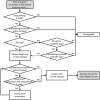Development of an algorithm to identify fall-related injuries and costs in Medicare data
- PMID: 27747538
- PMCID: PMC4701758
- DOI: 10.1186/s40621-015-0066-z
Development of an algorithm to identify fall-related injuries and costs in Medicare data
Abstract
Background: Identifying fall-related injuries and costs using healthcare claims data is cost-effective and easier to implement than using medical records or patient self-report to track falls. We developed a comprehensive four-step algorithm for identifying episodes of care for fall-related injuries and associated costs, using fee-for-service Medicare and Medicare Advantage health plan claims data for 2,011 patients from 5 medical groups between 2005 and 2009.
Methods: First, as a preparatory step, we identified care received in acute inpatient and skilled nursing facility settings, in addition to emergency department visits. Second, based on diagnosis and procedure codes, we identified all fall-related claim records. Third, with these records, we identified six types of encounters for fall-related injuries, with different levels of injury and care. In the final step, we used these encounters to identify episodes of care for fall-related injuries.
Results: To illustrate the algorithm, we present a representative example of a fall episode and examine descriptive statistics of injuries and costs for such episodes. Altogether, we found that the results support the use of our algorithm for identifying episodes of care for fall-related injuries. When we decomposed an episode, we found that the details present a realistic and coherent story of fall-related injuries and healthcare services. Variation of episode characteristics across medical groups supported the use of a complex algorithm approach, and descriptive statistics on the proportion, duration, and cost of episodes by healthcare services and injuries verified that our results are consistent with other studies.
Conclusions: This algorithm can be used to identify and analyze various types of fall-related outcomes including episodes of care, injuries, and associated costs. Furthermore, the algorithm can be applied and adopted in other fall-related studies with relative ease.
Keywords: Algorithm; Fall; Fall-related injury; HCPCS; ICD-9-CM; Medicare.
Figures



References
-
- Bureau of Labor Statistics. Databases, Tables & Calculators by Subject - Consumer Price Index - All Urban Consumers. http://data.bls.gov/timeseries/CUUR0000SAM?output_view=pct_12mths. Accessed June 2014.
Grants and funding
LinkOut - more resources
Full Text Sources
Other Literature Sources

